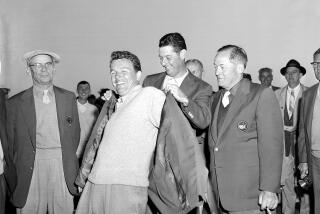Winning Is His Middle Name Again
- Share via
CARLSBAD — On a sunny Sunday in April of 1987, on a golf course in Augusta, Ga., a terrible thing happened to golfer Larry Mize.
Got struck by lightning? Well, in a way, yes.
He won the Masters.
It was not an accident. But maybe a mistake. On the second playoff hole, Larry Mize had missed the green to the right with his second shot. His opponent, Greg Norman, was sitting on the fringe with a birdie shot at the hole. Mize was 140 feet away.
He was really trying to chip it close when it trickled across the green and into the hole.
Greatly to his surprise, to say nothing of the rest of the golf world, he had won the 51st Masters, gone to join such legends of the game as Hogan, Snead, Nelson, Nicklaus, Palmer, Player, Watson and Sarazen. And he had just defeated in the playoff Seve Ballesteros and Greg Norman, no less.
Now, some players strive all their lives to win a Masters. And, as an Augusta-born boy, Larry Mize’s elation was epic.
But he had just let a 500-pound gorilla into his life.
Lots of things are too little too late, but for Larry Mize, this was too much too soon.
He had won only one other tournament in his life up to that point. And, he was not to win another for six years.
As Larry Mize, he was free to play his game on tour, which was to play the percentage shot, keep the ball in play, learn his craft painstakingly. As Masters winner Larry Mize, he was expected to play like a star. He had to go for it. No layup for a Masters winner. No lag putts. No protecting yourself on the money list. I mean, would Babe Ruth bunt? Red Grange run out of bounds?
Would Arnold Palmer lay up?
Larry Mize was only 28 when he won the Masters. He had been steadily successful on tour, improving annually. Until the Masters. He had won the 1983 Danny Thomas tournament at Memphis. That was nice but not historic. That didn’t interrupt the learning process so important to golf.
His game basically was not overpowering, it was straight. Mize kept the ball in play.
But now, he had new responsibilities. He had won a major. When he got up on a tee, the announcer trumpeted “And, now . . . Masters winner! Larry Mize!”
Big things were expected. Mize could not play his own careful, sensible game. He could not take what the course gave him. He had to shoot for its jugular.
There were other distractions. It has become commonplace in golf for champions to be whisked off for public appearances, corporate outings and other sideshows until their games disintegrate. Note how many people win a U.S. Open--then disappear from leader boards forever.
This was not precisely Larry Mize’s trouble. He did not let his game atrophy playing company treasurers on non-challenging tracks. Larry Mize put the pressure on Larry Mize.
“I shouldn’t have tried to hit the ball farther--but I did,” he was recalling as he underwent treatment for a stiff neck at the Mercedes Championships at the La Costa Resort and Spa this week.
“All of a sudden, I didn’t have the patience I used to have. I’m not a long-ball hitter. I hit it far enough, but basically I try to keep it out of trouble, set up the next shot.
“I started expecting things of myself that were maybe a little bit beyond my capabilities.”
In other words, he tried to become a combination of John Daly and Jack Nicklaus.
Golf is a game that doesn’t lend itself to daring. It is a game of control. It requires an understanding of yourself. Larry Mize began playing somebody else’s game.
Part of Mize’s game had been that he didn’t miss cuts. He made the top 60 in tournaments he entered. He made sure of it. Suddenly, he began to miss cuts.
Masters champions don’t miss cuts. So, gradually, Mize began to fade back in the crowd. The pressure decreased as the publicity decreased. The gallery expected less of him. So Mize expected less of him.
He put the experience to good use. “I began to understand the player that I am. I know my strengths. So I know my weaknesses, too. After the Masters, I didn’t play my game. I play my game now.”
The moral of the story is, a man should not really win a major until he’s ready for it. Ben Hogan didn’t win an Open till he was 36 years old. Then, he won four in five years.
Larry Mize’s Masters victory was not a fluke. He had played solid under-par golf all week. He had won $314,051 the year before, 17th on the money list.
As Masters champion, he dwindled to 62nd and 47th on the money list consecutively.
He didn’t remake his play; he remade the player. Larry Mize turned back into Larry Mize. He still went for the pin--but not if he had to hit it over the Empire State Building (or its equivalent) to get there. He didn’t turn back into a pumpkin. But he didn’t try to be Superman or John Daly, either.
He put the green coat back in the closet. He began to play the cards he was dealt. He made cuts. And in 1993, for the first time in six years, he won tournaments. He won at Tucson in January, the Buick Open in August. He was 13th on the money list, 13th in scoring average.
Then, he drew into the world’s richest (for the winner) tournament, the Johnny Walker at Montego Bay, Jamaica. He won like Secretariat--by 10 shots. Fred Couples had to shoot a last-day 64 to get that close.
The old Larry Mize won $550,000 for that one. The money was unofficial but cashable. With the $724,659 he won officially, it gave him a million-dollar year.
The object in golf is, be yourself. The courses, the clubs, the balls don’t respond to impostors. When you try to cut a dogleg you should shoot around, the course lets you know it is not impressed. It resents your putting on airs. It has an attitude: “That may be the Masters champion to you, buster, but it looks like Larry Mize to me.”
Of course, it’s well to remember that Larry Mize won the Masters as Larry Mize. Now that he has reverted to type, he might do it again. The course at Augusta might react: “Uh-oh, I remember this guy. Where has he been?”
Where he has been is trying to live up to his middle name, which is “Hogan.”
More to Read
Go beyond the scoreboard
Get the latest on L.A.'s teams in the daily Sports Report newsletter.
You may occasionally receive promotional content from the Los Angeles Times.










